How do I find out if I need to buy an audit?
So you’ve entered Buddler, ran an audit of your site or multiple sites, and received a preview with Traffic Opportunity Metrics. About time to figure out if the full version of the audit will be useful for you and if it’s worth buying.
A bit of activity to keep it interesting: choose an option from below and you’ll be sent to the block of the article that suits you.
About the Buddler concept and audits
Buddler is generally about mining and sifting, what has SEO and audits got to do with it?
A buddler in the realm of precious metals and ore mining is a person who maintains a chute where metal bearing ore is separated from waste rock by running water. Such chute is called buddle. Together with the ore, into the chute gets a huge amount of dirt, impurities and other things that are pointless to fingerpick. Instead, the ore is crushed and washed of dirt and impurities in the buddle. Only the valuable elements sought, such as gold, remain in the output.
A buddler gets the ore into the chute, operates the process, monitors and adjusts it to get the right result.
Our service operates based on the same principle, which is why we liked the name so much and chose it for our brand.
Other meanings of the word, whatever they may be, are irrelevant to the meaning we put in the name 🙂
So here is what our service and buddlers have in common and what SEO and audits have to do with it:
- Buddler fetches your site data from Google Search Console, often on a huge scale that you can’t parse by hand. Or you can, but by spending too many precious resources on it and without certainty that you’ll find anything useful
- Our service also collects and processes data that is necessary for some parts of the audit from your website directly
- It runs the data through the Buddler’s own algorithms, which are designed and developed by SEO-analysts with extensive experience and expertise in SEO, SERM, PR and marketing
- Our service detects patterns and anomalies, thins and weeds out what’s superfluos
- Analogous to impurities and waste rocks, instead of tons of data and useless tables, Buddler gives out useful insights, which in our view are like gold dust
The most notable difference is that our Buddler enriches the results with calculated values, metrics important for business, quickly adapts and responds to the changes in Google Search and user demand.
What is a “non-technical SEO audit” (or how Buddler audits are different from all other automated or manual audits)?
You can easily get large amounts of data about your site, especially technical data, from many SEO services. Sometimes even for free, like in Buddler’s Free SEO Tools, or directly from Goggle Search Console. Obtaining data isn’t a problem, and most likely you know from which services and with the help of which audits to get it if you need.
Technical audits are, in our opinion, the most common type of automated audits, because they are the easiest to collect and deliver. These are ordinary parsers, which make requests to the site or to some system. They get a response and adapt its content into a digestible human-friendly table. Such audits commonly contain information on page server responses, broken links, various dublicates, meta-tags, loading speed and hundreds of different parameters depending on the focus of the service.
We don’t aim to be another tech-audit service and have no ambtion to reflect all possible errors of your site in a giant report. Buddler’s mission is to automate the analytics of your site’s traffic and data, so that anyone can take a fresh look at their website and see individual opportunities to grow traffic.
We scrape a mass of data for you, just like an SEO-analyst or an internet marketer would. Except we use:
- computing power
- proprietary algorithms based on the experience of SEO-experts and working with thousands of sites of completely different types, topics, sizes
- statistics, which is replenished daily and allows us to build and test hypotheses to whom, how and what our reports will help
That’s why we offer non-technical SEO audit and do not compete with services whose goal is to throw a bunch of data into users. We highlight insights on the strengths and weaknesses of your website, and you decide what to do with them.
It doesn’t mean that we don’t take into account data fetched from your websites, just that we pursue other goals with our audits. We is committed to showing you as little as possible 🙂
Why “zero bullshit” (or why Buddler aims to show you less data)
Data itself is not valuable unless you know how to operate on it, or if you look at it without the big picture, or analyze it narrowly.
Yes, generally having data is better than not having it, but:
- Data won’t help you make decisions if there’s an overwhelming amount and you can’t process it properly
- Data won’t help you sort out what’s important if you don’t know where and what to look for
- Data won’t help you prioritize if everything seems equally important and you have to work with everything, or if nothing looks important and there is nothing to work with
- Data can be misleading if you use nonoptimal sampling or choose unsuitable analytics methods
- Data can lie, depending on how and from what angle you look at it, or how you present it.
Therefore, it is very easy to misinterpret data analytics. Data is just raw material, it can be more or less messy, more or less detailed, more or less meaningful, more or less accurate. To make decisions based on it, is has to be processed, thought about, analyzed. The larger the amount of data, the more challenging and time consuming it is to work with it and make conclusions, and the easier to make mistakes and wrong decisions.
So unlike many other SEO audit services or SEO specialists doing manual audits Buddler doesn’t try to overwhelm you with data and leave you to wander around in it. Buddler sifts through the data for you, eliminates redundant elements, minimizes the need for manual data processing and increases the productivity of people responsible for growing website traffic.
Buddler only gives away valuable data, that’s why Buddler is zero bullshit:
- NOT cluttered with meaningless data or big data that takes a lot of time consuming and relentless sorting through to catch valuable insights
- NOT another SEO service that offers enormous amount of data in order to sink and confuse you
- gives you an SEO audit that won’t have much data but will help you pick the low-hanging fruit of your site’s organic traffic
- gives you an audit that you can look at, understand and draw conclusions from even without being a SEO specialist or analyst
For whom it will be useful
Buddler isn’t equally useful for all sites without exception. We come up with new solutions and new reports that cover the needs of different sites, but all sites are not alike and therefore the benefits of Buddler are also not the same for everyone.
Most of all, the current version will be useful for medium, large and very large sites that are lightly or extensively neglected that have downward traffic dynamics or traffic stagnation.
If your site is completely event-driven and has extremely volatile semantics, the current version will probably give you some insight, but definitely not loads of it .We are already developing new additional reports that will cover even more types of sites and their analytics.
Still we recommend everyone to run the audits, since it’s free, and see if the audit is suitable for you based on opportunity metrics.
How to interpret preview metrics and figure out if you need to buy an audit (or how realistic are those numbers of yours anyway?)
Most likely the first thing you’ll notice when you get an audit preview is the common audit metrics.
The current version of Buddler provides the following general metrics:
- «Clicks in the last 30 days (GSC)»
- “Queries included in this audit”
- “All missed traffic”
- “All potential traffic”
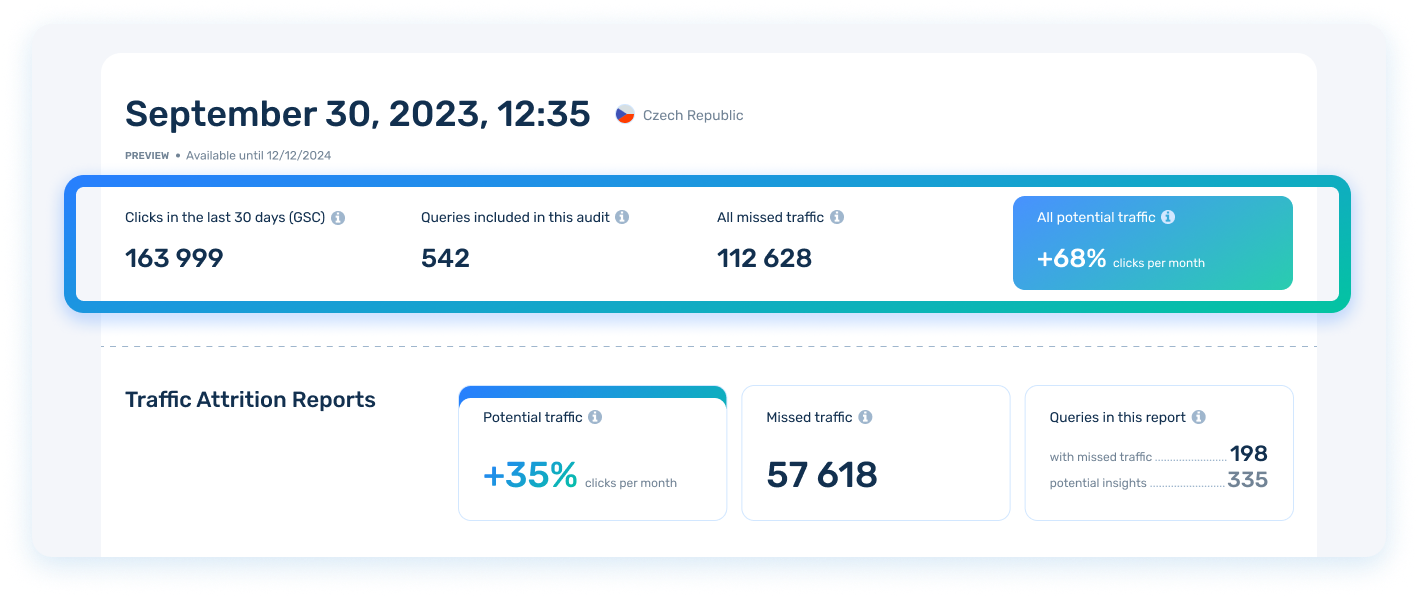
You can learn more about them in the tutorial. We love transparency, so we shared what exactly we calculate, how and why. Please read the tutorial if you still haven’t, it includes a special bonus and can help understand how to work using Buddler.
For those who already have or are not ready to read the article, here is a squeezed summary plus some thoughts on the metrics and their interpretation:
- The forecast figures are realistic and we deliberately underestimate them
- We don’t evaluate in traffic what we don’t think is clearly profitable for the site
- Don’t look at metrics in isolation when deciding to buy an audit, they are illustrative if you look at them in an integral way
- Buddler takes the massive amount of raw data from Google Search Console, content from your website and turns it into useful insights.
- Buddler highlights simple ways to increase organic traffic that work specifically for your site.
- Buddler shows the potential of your site, including the missed traffic, for free, suggests you evaluate the profits you can get and consider buying a full audit.
What Buddler doesn’t do:
- Buddler is NOT in the business of predicting the future.
- Buddler does NOT give you magic pills or one-size-fits-all recommendations.
- Buddler does NOT give you a ton of data and mind-blowing metrics that you won’t even know what to do with.
If you aren’t sure that it’s worth buying for the sake of this amount of traffic and insights — better don’t, you are not obliged to anything. You just received information about metrics and found their values not interesting enough for a particular site.
The metrics are displayed in Buddler for free exactly for you to estimate if it’s beneficial for you to purchase a full audit based on the forecasts of missed traffic, query volumes and insights that await you in the full version.
If the forecasts seem interesting to you and you would benefit from even a fraction of what is reflected in the figures, if you realize that the traffic the service predicts is not a guarantee, but it would be easy to gain, buy the audit.
Audit metrics cases, what to expect in metrics (or when you should or shouldn’t buy an audit)
CASE 1: Audit collected with very high percentages of Potential traffic

Wow, pretty numbers! Potential traffic is estimated in hundreds of percentages! Is this even normal?
Quite normal, just take into account your current traffic results and potential traffic results to evaluate the real expression of potential traffic.
Examples of frequent combinations:
- High values are displayed if the site’s organic traffic has recently sagged noticeably compared to previous periods and you indeed have something to regain. In this case, the results of the first report are likely to be high, because it informs exactly about such queries.
Depending on the volume of “queries with missed traffic”, we can conclude that a lot of queries have dropped. Perhaps most of them are medium-volume or low-volume, because the ratio of missed traffic in the report and the number of queries indicates a massive decline in query results. If you don’t generally see a decrease in organic traffic, perhaps there was a compensation growth somewhere else, but a significant number of queries for your website still dropped. Such massive drops are often associated with major errors or big changes on the site, as well as a change in business focus or a product matrix update. Recall the latest changes, and a full audit will help to understand for what queries and when it happened.
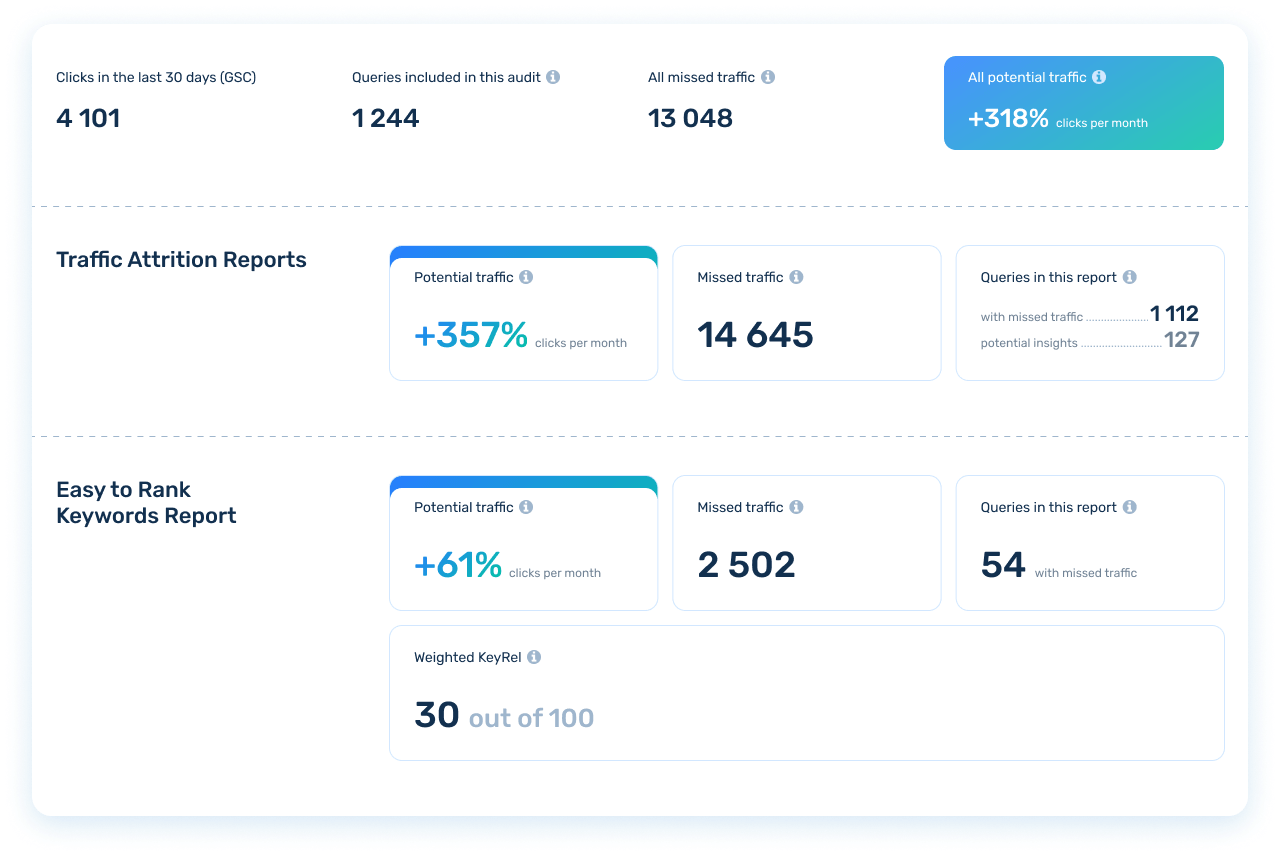
- In case there is multiply more missed traffic but you see a small number of quieries with “missed traffic” in the first report, then you can assume that there is a significant drop, now in high-volume queries. As the queries are few, and the potential traffic is significant, one query can gain more forecasted traffic, so they can be considered high-volume. For these queries, the site was previously on higher positions, and by returning the positions and click-through rate you could also multiply your current traffic.
Perhaps these queries had a simultaneous drop in position and increase in demand, that’s why the potential was not so high before, and now you start to miss more traffic. Earlier queries may have been less popular and less competitive, but you still managed to take the best positions, so probably even in conditions of high competition, it makes sense for you to fight for these queries and if not fully restore positions, then at least grow them. You will be able to learn such queries in a full audit and decide for yourself if you are ready to recover them.

- With little traffic, even a few hundred clicks of potential growth can give a grand percentage of Potential traffic. So pay special attention to the ratio if the current performance of your site isn’t high. With semantics of sufficient demand, you can get 2-3 times or even 10 times more.
But since the potential increase can be fairly small in number as opposed to percentages, it might make sense for you to think in the direction of analyzing the data manually and revising your semantics, without buying out the audit.
If you have a narrow and low-competitive niche, attracting even that much traffic with an audit will pay you back, and you want to get insights, because you have, for example, an incredible conversion rate or you don’t see insights in manual analytics — then why not, the audit will show you what to pay attention to.

Conclusion: When making a decision to buy, look at all the numbers in tandem! High percentages predictions have a solid base, but how important they are for your particular site you can evaluate by looking at the metrics ratios.
CASE 2: Audit gathered with abnormally low Traffic Opportunity Metrics

The audit was collected, but the lost and potential traffic metrics are unnaturally low or even zero.
There can be a lot of reasons for this, here are the most common of them:
- Queries with missed traffic are few and most of them are not used in the missed traffic count or not used at all and consist entirely of queries that are added to the audit as insights. Such audit results suggest that either we didn’t have enough data to analyze — too low traffic, data gap on the Google Search Console side (but in case of problems with GSC in most cases the corresponding alerts will be displayed in the preview)
- The requests included in the report are mostly low-volume and the amount of traffic is close to the number of “queries with missed traffic”
- Your requests do not fall under our algorithms in the current version. Perhaps your website has event-based semantics and we didn’t see any significant patterns in the historical data
- Perhaps you are doing great, you are in the growth phase, not losing anything, you follow new queries trends and boost the site evenly and regularly
Conclusion: Such an audit is not worth buying. You can run the audit later and check if anything has changed. Right now it will not give you ideas and food for thought. Perhaps our new reports will be able to reveal opportunities for your site.
CASE 3: Audit was collected with a large difference of potential traffic in the reports


Such a situation is possible and quite normal, because each report has its own data analysis methods and considers different aspects of the site and its traffic. That’s why it’s normal to have a situation:
- where one of the reports will not have any data at all
- where potential values will be displayed with a big difference, regardless of which the report will have less or more data.
- where there will be roughly equal forecasts
Conclusion: Audits with large differences in forecasts in reports can be bought, it’s okay to focus on the overall metrics and results of reports with forecasts. If you are interested in audits in general, buy them.
CASE 4: The audit is collected with an error. Is it worth buying an audit if the data in the audit is incomplete?
It can happen that one of the reports will have an error, for example the audit will not be collected completely. There can be various reasons for this.
For example, you see an error like this:

It is related to technical issues of data acquisition and processing. If the technology on your site does not allow you to spar text, we will not be able to collect Easy to Rank Keywords Report; if there is not enough data in Google Search Console, we will not be able to collect Traffic Attrition Reports.
Some technical issues may be intermittent; it is possible that if you run an audit with this error in the next 24 hours, the audit will be fully collected.
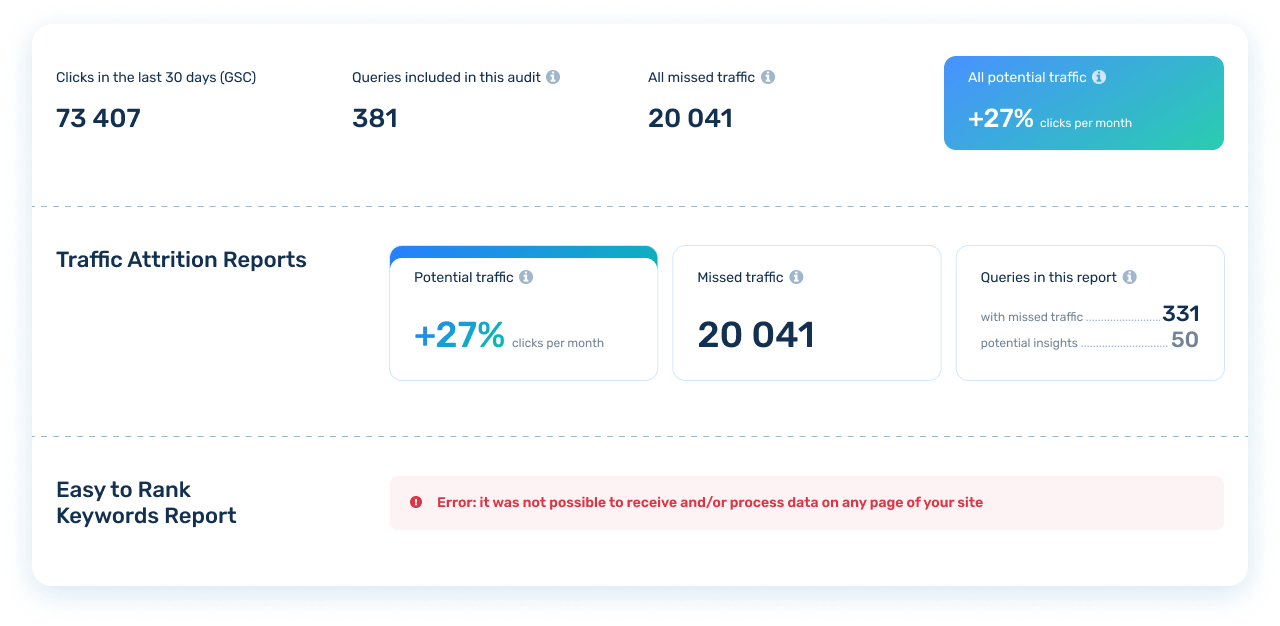
Other restrictions are permanent. For example, if the language of your site is not included in the list of supported languages for Easy to Rank Keywords Report, you will always receive only Traffic Attrition Reports in the audit.
You can learn more about possible errors in the Alerts and Limitations article.
For example, in this audit we see that in one report we have more than 100 percent of potential traffic, 376 queries with traffic and 47 queries with insights, for the owners of this particular site it is a significant volume and to see where the sagging is can be very useful even without getting the second report.
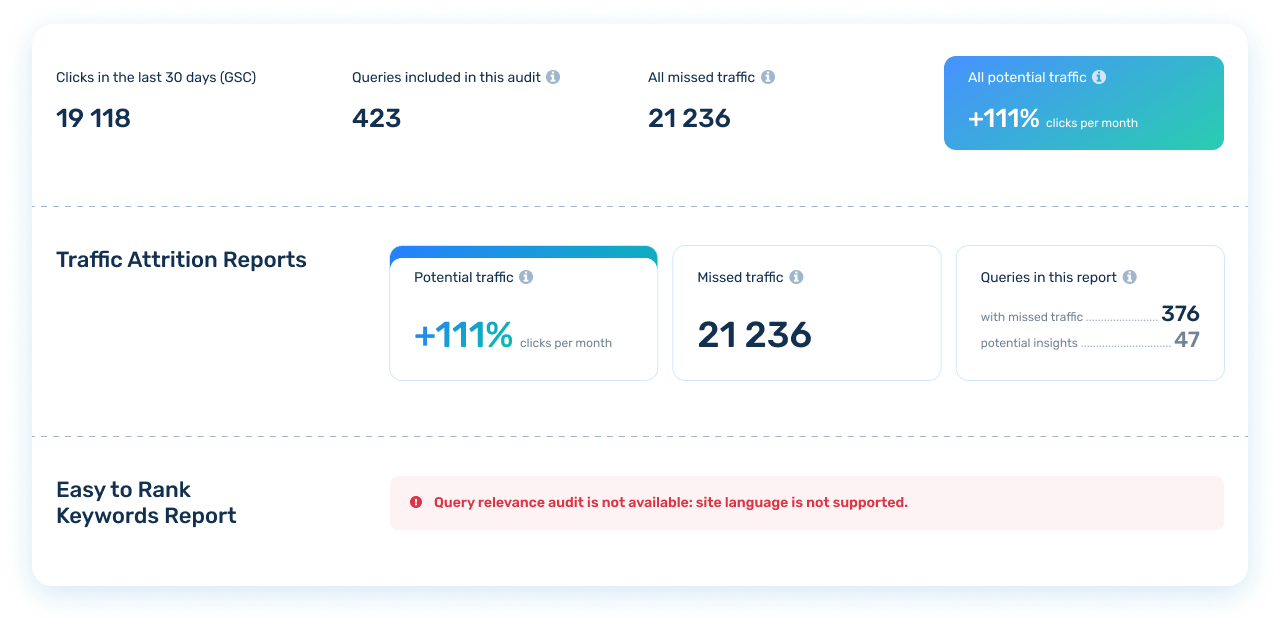
And in this example, the potential is not as significant, so it’s not as interesting to buy the whole audit after seeing just one report.
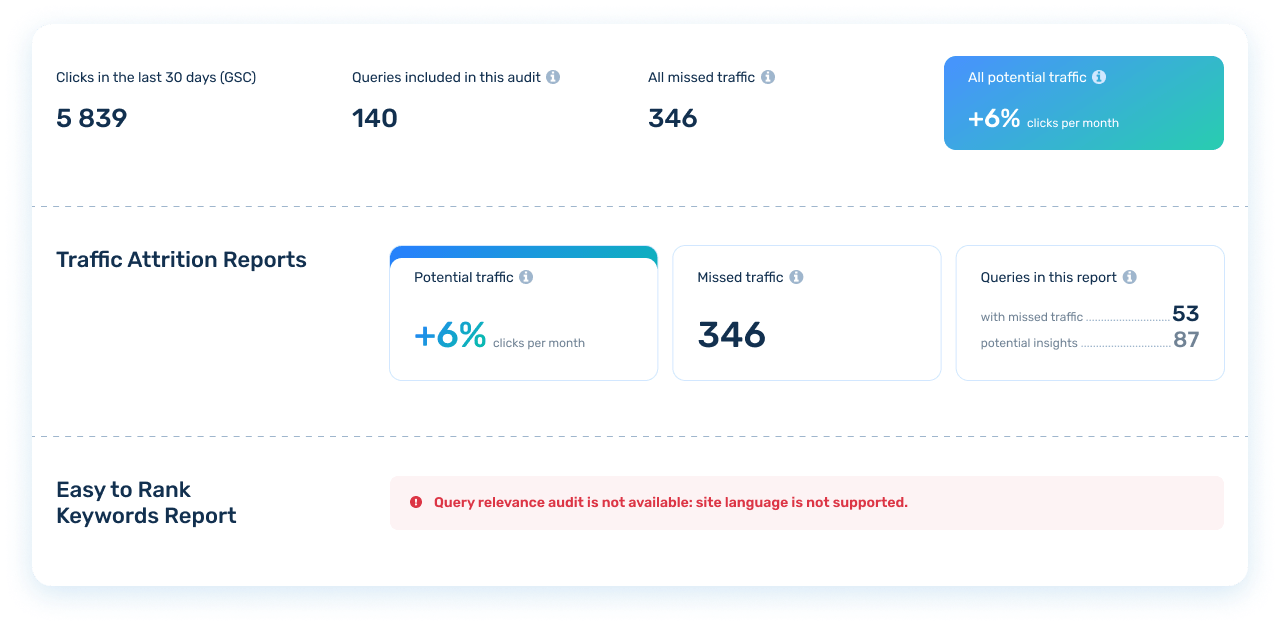
Conclusion: if the error is technical, try restarting the audit in the next 24 hours. If the audit is again collected with an error in one of the reports or the error is not technical, make a buying decision by evaluating the potential of the available report: what is the share of potential traffic from “clicks in the last 30 days” and what is the volume of missed traffic.
If you realize that both reports should be collected and there is no reason for the audit not to be collected, but the error is still coming out, contact our tech support. We will see what the problem may be and let you know whether the audit can be collected completely or not.
CASE 5: Audits are collected on the domain resource and the main version of the site with the same results

The data in the domain resource and the main full active version can be the same. If your versions are different and the data in the reports are different, then they have different histories in Goggle Search Console and it makes sense to treat them as separate analytics with different results.
For example, it can be the whole domain resource and its separate folder or a separate section dedicated to something. If you want to treat this section as an independent resource, semantics of the section should not overlap with the rest of the semantics, and analytics of your data should ignore the rest of the site — use i. If not and you still want to see the big picture and the history of semantics, its migration and results within the whole resource you are interested in — take data from the domain resource.
Conclusion: If the data of the domain resource and its versions of sites is the same, you should not buy both, take one of them. If the data is different and you are interested in all sections — buy at your discretion and for your purposes.